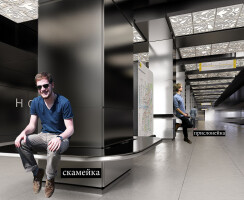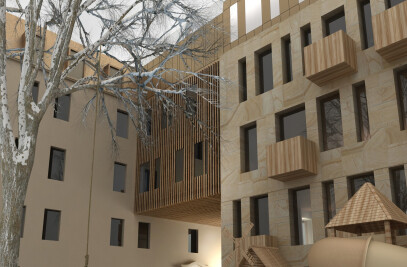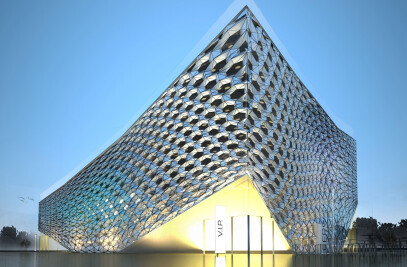U-R-A CHIEF ARCHITECT EVGENI LEONOV COMMENTS ON WINNING THE NOVOPEREDELKINO SUBWAY STATION DESIGN
CONTEST. We are sincerely glad to know that 300,000+ Moscovites have took part in the voting and viewed our work as the best! And what more, we are excited to know that this opinion of citizens was shared by the Contest judges! It is common people that use subway stations, and thus Moscow Mayor Sobyanin’s idea to involve such common people into the decision making process seems really trendy and reasonable. Our project is truly Moscow-ish and Russian in the style. We implemented the archetypal Moscow motifs into modern materials and state-of-the-art technologies. The key component of the interior is light panels perforated in the Russian-style pattern. These panels are united into light boxes with their contours suggesting of the Kremlin chambers. Upon passing through the pattern, light creates a lace of lights and shadows. And moreover, the colours may be changed! Integrated RGB LED emitters may change colours of the emitting rays and, for the city holidays and other events, the Novoperedelkino station has all the opportunities to become amazingly variable.
What we found most difficult about the Contest was the necessity to handle the already-given standard project. That is why we were especially glad to see a variety and creativity of all projects submitted for the Contest.
We still have a lot of complicated work ahead, since both deadlines and budgets are tight.
We have to express many thanks to the Contest organisers, the Mayor’s office, and the subway administration, for the impeccable arrangement of the Contest.
NOVOPEREDELKINO SUBWAY STATION: ARCHITECTURAL CONCEPT. The main idea of our concept was to combine the archetypal motifs of the Moscow architecture with modern ways of interior decorations and, moreover, make the station a truly unique and dynamic place.
Metal panels, perforated in the Russian-style pattern, comprise light boxes and disperse light. The patterns create a lasting and expressive experience.
The prime feature of the station is a variety of experiences created. Being equipped with RGB LED emitters, light boxes – either flat or domed – may change their colour scheme. During city holidays and other events, such patterns may become blue, red, or multi-colour or even broadcast videos.
The Novoperedelkino district is renowned for its unique forests and such identity was expressed in the pavilion decorations – laser engravings in the decorative glasses are reminiscent of forests made-up of pines and birches. LED backlighting makes the engravings fluoresce, creating an almost 3D image of a forest around.
Thus, we aimed at supporting time-proven trends of artistic architecture at the Moscow subway, through creating innovative ideas rather than simple copying of old concepts.
Pavilions above stair approaches and elevator pavilions for people with reduced mobility.
The pavilions are constructed of steel frames to which glass panels are attached. Such solution has been applied in mane recent pavilions, such as Zhulebino and Alma-Atinskaya in Moscow, Benimàmet in Valencia, and more. The dual pitch roof is hidden behind glass facades. The pavilion decorations are reminiscent of tree trunks. Novoperedelkino is famous for its pine forests and birch groves, so we think the suggested pattern would become a symbol of the district’s identity.
The patterns are sandblasted within the 3-layer glass. If backlighted by LED, the glass panels with patterns become fluorescent. The birch pattern makes a standard pavilion look like a unique and expressive object in the city.
The pattern will also be used in the near vicinity for landscaping purposes.
Under-street passages to vestibules. Passages are primarily decorated with flat light boxes. Behind perforated aluminium panels, there are RGB LED panels made up of LEDs manufactured by Optogan company which is supported by the Rosnano innovation fund. Integrated LED panels have light-pervious plastic housings (flammability class G1, dust-permeability class P65), could be changed in a couple of minutes, and may work for 10+ years. Since LEDs are directed to the butt end of the light-pervious plastic sheets, while dust might accumulate above the sheet only, such dust would not hinder the light and operation.
Due to their perforated patterns and changing colours, RGB LED panels create soft ambient light with strong emotions. The station panelling is polished stainless-steel, to reflect patterned light boxes and colourful lighting during city holidays, thus making a celebrative air.
Twin rails – for both adults and children – are designed to be of the surgical metal with anti-bacterial coating.
Ticket hall and elevator/stairs zone. Light boxes are shaped as Moscow chamber vaults and made of perforated panels. The vaults create the gallery – a visual passage that helps to establish a sense of direction. Upper levels of the interior are bright and imaginative, while lower levels are ultimately functional and convenient for people movement. As light boxes remind of vaults, this expands the hall and makes it look grand. The hall ceiling seems to be much higher than it actually is – 560 cm between the floor and ceiling. Ambient light helps to make the station look warm and spacious. Light boxes may change their colour in every area of the station, being attached to pillars via steel frames. Our lighting designers managed to find a simple and elegant solution for vault lamps – standard line lamps would be installed along the upper and lower contours of the light box only, while the internal white space in the box would reflect and disperse light throughout the box. Thus, it would not be difficult, if needed, to replace several standard lamps of the same line. Open perforations would not hinder passage of dust, which makes cleaning easier.
Platform zone. At the 2d stage of the Contest, we suggest installing flat light boxes above the platform, to simplify serviceability. The light boxes are made of steel frames and open perforated-steel panels. Since the panels are open, they will not hinder passage of dust and make the panels easier to clean. Inside panels, standard RGB LED line emitters are used. This helps to both achieve better energy efficiency and change colour scheme at the station during city holidays and other events. The station walls and ceiling are panelled with polished stainless steel. The combination of the lighting scheme and panelling materials creates an amazing effect similar to polar lights. Besides, the steel reflections do not hinder train drivers’ vision and are often used for subway station decorations. Antismoke screens and ventilation boxes of the smoke-extraction system are located between and above of light boxes, with doors of cable boards integrated into the wall panelling, thus making the engineering systems not visible. Each pillar has both benches and areas to lean against.
Style-Making Components. The prime decorative component is the Moscow pattern, to be applied in the light box perforations. Light boxes have varying shapes - flat, crisscross, and domed. Each type of light box is located at a separate zone of the station. The boxes are equipped with RGB LEDs and may change their colour. The boxes are segmented into small opening panels with a RGB LED emitter within. LED lamps have longer service lives and the panel leafs are soft in opening, thus making the station servicing easier.
Lighting Concept. Our lighting concept had its prototype at the HafenCity station, Hamburg, which has a row of light boxes hanging above the platform. The boxes are made of steel frames and light-pervious panels, with 280 RGB LED emitters in each box. The colour scheme of the station may change, depending on train arrival or environment, such as season, daytime, or even mood of the station manager.
For the Novoperedelkino concept, we suggest replacing hanging containers with patterned light boxes and making them look like vaults. In the under-street passage with much lesser dust contamination, we suggest installing horizontal light boxes made of closed panels. Variability is a basic idea of our concept. RGB LED allows changing a colour scheme to create varying air at, and appearance of, the station. For city holidays, the station’s colours will be in line with the holiday theme. The visualisations show some sample of such thematic colours – Spring, Spartak the Champion, and New Year. People would be delighted to see such variability. Also, colours may be changed slowly during a day - from active tones in the morning to calm shades in the evening. Moreover, as lighting colours need to comply with sanitary standards and specifics of space perception when moving; and every lighting theme need to include white; this means that colour schemes should be developed by expert professionals.
Colour therapy is a long-standing healing method. Our station will be in line with this traditional method and helps to raise people’s moods by using various colour schemes. The LED lighting is deemed to be better for human eyes that the luminescent one, as is currently used in the Moscow subway. LED advantages are as follows: no flickering, higher colour output (Ra > 80%), and energy efficiency (by several times).
Lighting System Operation. To simplify serviceability, we arranged light boxes as small panels (60 cm x 60 cm). Panels could be opened as leafs thus making the RGB LED replacement fast and easy. For instance, the under-street passage has 22 light boxes with 198 metal panels and removable RGB LED panels within. An RGB LED emitter’s service life exceeds 50,000 hours. Its takes 5 minutes to change one RGB LED lamp in the lightbox panel. Based on this, we estimate the servicing time for one under-street passage as approximately 6 man-hours per operation year.
RGB LED Lighting Management. Light boxes are connected to and controlled by the central lighting management system. To control both RGB and White lighting, we suggest using the dedicated software of the Russian origin. The station manager may change the light intensity and theme, using the lighting management software at the personal computer. The dedicated software supports as follows: 1. Separate lighting management for all station zones – platforms, passages, entrances, etc., at which DMX-controlled lamps will be installed. 2. The lighting scenarios will be in accordance with the operation schedule, which helps to improve energy efficiency of the system. 3. Lighting scenarios could be adjusted for each zone of the station separately, for the entire calendar year, for each holiday and season. 4. Audio reels at the station may be combined with the lighting scenarios, thus creating a unique atmosphere. Such audio support may be either pre-programmed or chosen manually.
Ornament Themes. We intend to support the artistic trend in the Moscow subway decoration by choosing ornament-perforated panels. The Customer may choose three ornament options (themes), such as Birch Trees, Subway, and Khokhloma. At the Project implementation stage, the Customer may either choose one theme or combine several themes.
Ornament theme: Birch Trees The Novoperedelkino district has always been famous for its unique micro-climate fostered by surrounding forests. In this area of Moscow, woods are dominated by birch, spruce, and pine. Near Moskovsky town, you may find the unique old birch groves. Birch and pine may be viewed as an identity component there. For a megalopolis’ districts and vicinities, which are sometimes just faceless, an identity is of prime importance. We developed ornaments for the panel perforation – tree leaves, trunks, and brunches – specially for this Project.
Ornament theme: Subway When developing this theme, we aimed at creating a corporate ornament of the Moscow Subway. Using the Moscow Subway logo, we suggest ornaments of varying style – from folk motifs to abstract ideas. These ornaments are distinctive for their visual perception: from a distance, they look like a single pattern, while at approaching, they turn to a sequence of ‘M’ letters. (‘Metro’ means ‘subway’ in Russian.) These ornaments may be used for both station decorations and other printed materials and become a part of the corporate style. We developed the ornaments with the Moscow Subway logo for this Project specially.
Ornament theme: Russian Patterns Patterns used for the 1st stage of the Contest are easily recognizable as those relating to the Russian folklore, decoration themes of the Old-Russia architecture, and Moscow ancient palaces. We believe that patterns like this may be popular, being composed of grass motifs, curls, Zhar-Ptitsa (Fire Bird) feathers, and bells.
Navigation System We intend to use the transit navigation system developed by the Moscow government. The system is based on the idea that the city transport is a single organism of inter-related components. Line charts serve to clarify the route and find the destination and transfer stations, if needed. The subway chart serves to plan a route and find the destination and transfer stations, if needed. Exit schemes serve to find the destination station and an exit needed. The subway could also have the floor navigation in accordance with the current design. Visually-impaired persons may use the floor navigation based on tactile surfaces of varying grooves.


































